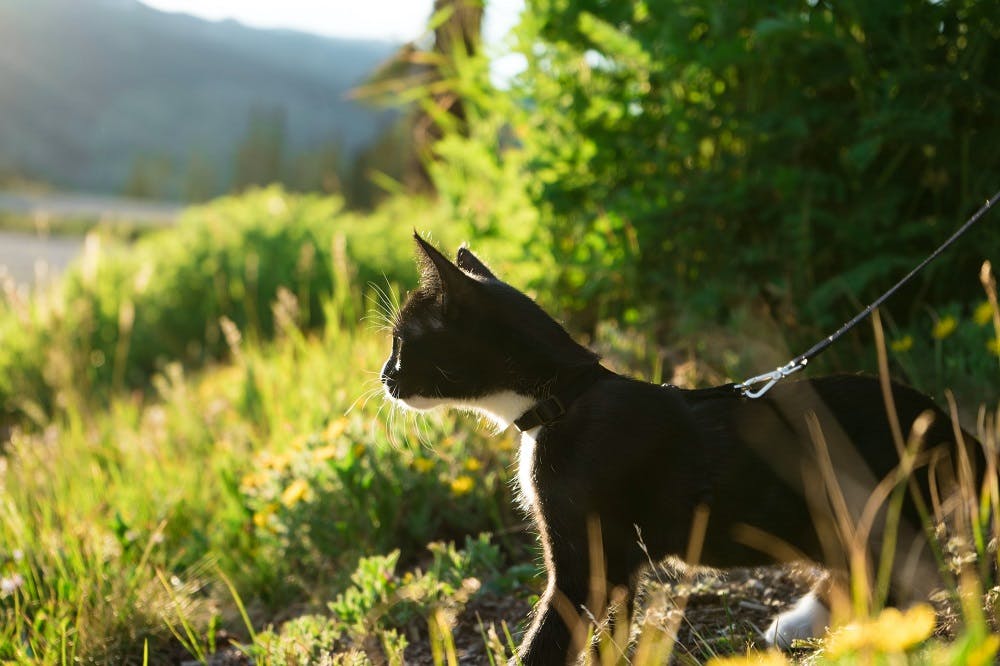Guides, Pets
Exercise Tips for your Dog or Cat
Pets give us a lot of love and affection and health benefits to you and your family. Cuddling your pet is vital for health and happiness, but exercising them is also very important. You don’t want them to become lazy and overweight. This article is going to help you understand the fitness needs of your furry friends and what you can do to inspire and help them exercise and be happier members of your family. Plus, how to make exercise fun and not boring!
![featured image for [object Object]](/_next/image?url=https%3A%2F%2Fimages.prismic.io%2Ftrs-storefront%2F44f8bb8c-10b4-4dbf-a49b-45afc7915bf3_blog_top-exercise-tips-to-keep-your-cat-or-dog-fit-and-healthy..webp%3Fauto%3Dcompress%2Cformat&w=3840&q=75)
The Reject Shop
Last updated
3 Aug 2023
The Benefits of Exercising your Dog
There are health benefits to exercising your dog, but there are also behavioural and bonding benefits too.
Health Benefits of exercising your dog
Walking your dog, and other exercise routines keep your dog fit and healthy. It helps to keep their blood pressure low and build muscle, keeping them lean and of a good weight for their size.
Walking your dog, especially if they are trained to not go toilet inside the house, helps keep them regular. If your dog is holding on because they’re inside too much, they run the risk of constipation or a urinary tract infection.
Another side benefit of you exercising your dog is that you get exercise too. You can get fit and healthy while bonding with your pet!
Plus, if your dog enjoys walks, they can quite easily motivate you to take them. Imagine them bringing you their walking lead, tail wagging madly. How could you say no?
Which brings us to...
Emotional Benefits of exercising your dogs.
Your dogs will connect the joys of getting outside with you. They will create a stronger bond with you. This helps your dog, and you, emotionally. It promotes the happy hormones in your brain.
If dogs are left indoors all the time, they get depressed. They know their own home, the sights, the sounds, and smells. And it bores them.
Take them outside to the world, with new sights and a load of new smells, and you’re the one taking them? You will increase your dog’s happiness and friendliness and build a stronger bond between you and your dog.
Behavioural Benefits of Exercising Your Dog.
Exercise prevents your dog from getting bored. Left alone at home, or in the yard, they will get depressed and anxious and act out in bad ways. They can take their frustration out by grabbing clothes off the line or digging holes in the garden. Indoors they could chew on things they shouldn’t, just because they have nervous energy they need to get rid of, and they want to get out and exercise.
Exercising them releases this nervous energy. Have them running around off-lead and all that twitchy behavioural issues will be solved.
Outside Activities for Your Pets
Let’s begin with what you can do with your cats and dogs outside.

Photo by Lucas Ludwig on Unsplash
Outdoors with your cat
Cats do love the great outdoors. They are natural hunters and quite adept at catching wildlife, so if you’re going to exercise your cat outdoors make sure they are under supervision or contained.
- Outdoor Playpen – you can fence off a certain area of your backyard, which can include a tree and other climbing equipment. That way your cat can climb trees, laze in the sun, but within a contained space without the risk of getting out and harming native species.
- Walking and hiking- with the right training and a good cat harness, you can take your feline with you on walks and hikes into the wilderness. Cats are curious and not only will they get great exercise with walking, but you can also satisfy their need to discover new things.
Indoors with your cat
Traditionally cats are indoors creatures and love nothing more than taking a nap in a sunbeam. Or running madly around the house at 3 am. There are things you can do with your cat to keep them busy and fit indoors.
- A Cat Tower- this helps them with their climbing and agility. It also gives them somewhere to scratch and mark their territory.
- Toys- Cats are natural predators and will leap and pounce on many things. Giving them a lot of toys to play with will keep them entertained and alert. Ping pong balls are a good idea. They can’t get their claws into it, so it will keep popping out and rolling away, making them chase and hunt it down again.
- Laser pointer- you’ve seen the funny videos. Cats will instinctively hunt and chase that crazy red moving dot. Just don’t shine the laser into the cat’s eyes as it will damage them.
- Wand Toys- a feather or ball on the end of a wand you can flick around and make your cat leap and pounce for it. A lot of fun and short burst energy exercise for your cat.
Outdoors with your dog
Dogs love being outdoors. Well, most dogs. Running after sticks, jumping into puddles, and roughhousing with other dogs, they can’t get enough of it.
- Walking and Jogging- possibly the simplest and most common form of outdoor exercise for your dog, and for yourself. Grab a lead and a harness and take them with you. Train your dog to stop at the edge of a road, and to obey your commands. This makes it a more enjoyable time for you both.
- Off-lead parks- this is a lot of fun for your dog. Being off-lead in the great outdoors so they can run around, get the ‘zoomies’, will get them fit and tire them out.
- Fetch- throwing the stick, or the ball, and having them fetch and bring it back is enjoyable. It’s a good idea to have a glove to pick up the ball, or a ball-throwing apparatus, so if the dog is a little drooly you won’t get your hands dirty.
- Swimming- this is awesome aerobic exercise for dogs, and low impact. Good for the older dogs.
Indoors with your dog
Sometimes you can’t take your dog outside to play. You have to learn to entertain them in the house. That’s cool, there are plenty of ways to do that.
- Stairs- having your dog running up and downstairs is a great workout for them. Chasie, hide-and-seek or hunting treats are all ways you can have them running the stairs.
- Tug-of-war- Get yourself a tug-of-war toy and help build their muscle mass and bond with you.
- Agility training- you can set up an obstacle course; winding through table legs, jumping over couch cushions and more. Lead your dog through it so their leaping and jumping and improving their agility.
How much exercise does my pet need?
The general rule of thumb says that the younger your pet, the more energy they have so the more exercise they need.
How much exercise for my dog?
Puppies have a lot of energy to burn, but only in short bursts. A long walk will tire a puppy out very quickly. But some short zoomies around the backyard and a few goes of fetch will have them satisfied.
Adolescent and mature dogs can go for longer walks, and older dogs not so much.
Also, the breed of the dog will help determine how much exercise they can handle. Border Collies can go on almost forever chasing sticks and tennis balls. Basset hounds? Not so much.
Understanding the age of your dog, and the breed will help determine how much exercise they need and can handle.
- Puppies- Exercise in short bursts.
o Short walks, short play times, many times a day. - Adolescent dogs- Long walks twice a day if you can.
o Off lead in a park.
o A session of swimming once a week.
o Playing fetch and tug of war every day. - Older dogs- One walk a day if you can.
o Some gentle agility games inside the home.
o Fetch if you can but at a slower rate. - Energetic breeds – e.g. Terriers, Border Collies, Australian Sheep Dogs.
o Need a lot of exercise as they have a lot of energy. Understand this before owning a dog such as these. - Lower energy dogs- e.g. Basset Hounds, Maltese, French Bulldogs, Pugs.
o Still need exercise, but not as much. They have smaller engines and can’t do as much.
How much exercise for my cat?
It is the same with cats. Kittens are bundles of energy and will playfight and pounce and then suddenly drop to nap time.
Adolescent cats are always up for some pouncing fun. Older cats prefer a bit more of a lazy relaxed lifestyle.
Also, the breeds of cats have varying energy levels, and you need to consider this when choosing your feline companion.
- Kittens have energetic bursts. Short sprints of play before they need to nap.
o Playfighting with other kittens, pouncing with a wand, or chasing a laser pointer when they are awake is good. - Adolescent cats
o A lot of energy and a big desire to nap during the day.
o Get them outside exercising at least once a day.
o Grab the laser pointer or the wand three or four times a day. - Senior Cats
o Not much exercise for the senior felines.
o Get them walking when you can, following you around. Bribe them with treats to get moving.
o Watch their diet. With little activity, they may eat and get a bit overweight. - Energetic breeds of cat- these can include- Devon Rex, Abyssinian, Burmese, Bengal
- Lower energy breeds of cat- Himalayan Short Hair, Ragdolls, Persian, British Shorthair.
Exercising with your pets is a wonderful way to bond and become closer to them. Plus, a fit and healthy pet will live a longer and happier life with you.
Check out our great-priced pet accessories to help you and your pet be active. The Reject Shop sells what you need for the best pets ever.
Sign up to receive exclusive offers, VIP invites and all our hints & tips
